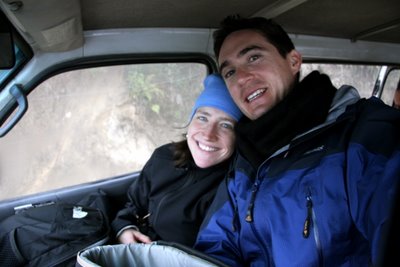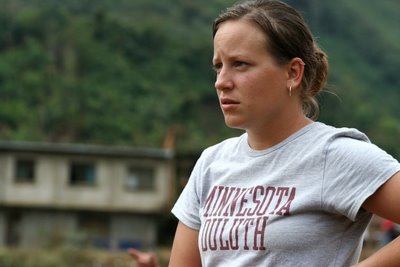Time for you to get a break from me (in other words, time for me to crank out two slideshows, a two-campus quickie exposition of photos, a final-exam/scavenger-hunt, and final grades for 3 different departments in 48 hours.) But more to the point, time for some Guest Bloggers. Here's part of an e-mail from Mike, who just finished 3 days with Ginger in the Salt Flats last night. Their adventures are far from over, however . . . read on . . .
——————————————————————————
Buenos dias amigos,
Currently typing on the worse keyboard in all of Bolivia. And I love it.
First, Zac give Margaret the biggest Carmen Pampa hug from Ginger and I. You have to give it, because we won't be able to. We're currently prisoners in Uyuni. The great people of Uyuni, Potosi and Oruro are blocking the roads prior to the voting on Sunday to protest the terrible road conditions (I happen to concur with them there). Our jeep back from the desert was blocked coming into Uyuni (we hiked back into the city -- felt good actually after the 8 hour jeep ride), and our bus to La Paz was blocked from leaving last night, at this point indefintely. There are tragically wronged gringos aplenty roaming the streets of Uyuni. We paid for, but then bailed on, a secret Swedish mission to escape last night -- five (some of them very cute, including my Todo Tourismo first crush) touristas packed into a desert jeep and snuck out under the cover of darkness to make it to Oruro (not clear how far they made it, but I wish them my very best). They had flights to Costa Rica Saturday morning, so their situation was more desperate. Ginger, not feeling the 12 hr jeep ride after having traveled all day in a jeep, decided we should skip the Mission Impossible, and sleep in. Granted, we have had some superb Boston pizza, and the best cafe leche south of Carmen Pampa, but given that we've already seen the train graveyard, there's not much left for us to do in Uyuni (save joining the blockades on the roads, which given the look in the eyes of the kids willing to throw rocks through the window of our jeep, probably wouldn't be as welcome as I might hope). So much for "Si, Se Puede!" But we're in good spirits, having had an splendid road trip through the desert and volcanic southern altiplano. Cold as hell, as advertised, but breathtakingly beautiful in all its myriad forms.
We'll see if the civic comission lets a group leave for either Potosi or La Paz tonight -- looks like a quorum of pleading whiteys are making headway on the bus to Potosi, but Ginger and I are hopeful for a path through Oruro (the trek to Potosi-Sucre-La Paz could be hazardous to our pleasant psyches right now) Haven't showered in 4 days, and dogs are beginning to think of me as one of their own. Tis life in the Wild West, no?
——————————————————————————
Trapped as he is in Uyuni (a town best known for its surreal yard of abandoned rusty train parts), Mike didn't have time or bandwidth to include a photo. So I hunted down one from my time in Uyuni in May . . . I thought this piece of public art was apt.

























